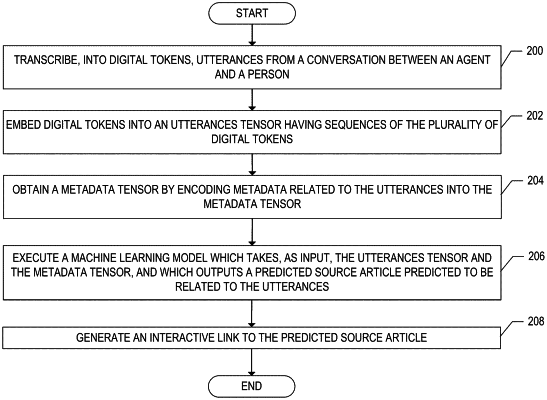| CPC G10L 15/18 (2013.01) [G06F 16/9538 (2019.01); G06F 40/284 (2020.01); G06N 20/00 (2019.01); G10L 15/063 (2013.01); G10L 15/16 (2013.01); G10L 15/22 (2013.01)] | 15 Claims |

|
1. A method comprising:
transcribing, into a plurality of digital tokens, utterances from a conversation between an agent and a person,
wherein transcribing the utterances into a plurality of digital tokens further comprises transcribing the utterances into a first sub-tensor comprising a first sub-plurality of digital tokens representing first utterances by the agent, and a second sub-tensor comprising a second sub-plurality of digital tokens representing second utterances by the person;
embedding the plurality of digital tokens into an utterances tensor comprising sequences of the plurality of digital tokens, wherein embedding the plurality of digital tokens into the utterances tensor further comprises concatenating the first sub-tensor and the second sub-tensor into the utterances tensor;
obtaining a metadata tensor by encoding metadata related to the utterances into the metadata tensor;
executing a machine learning model which takes, as input, the utterances tensor and the metadata tensor, and which outputs a predicted source article predicted to be related to the utterances, wherein the machine learning model comprises a convolutional neural network and wherein executing the machine learning model further comprises:
applying the first sub-tensor to a first stack of convolutional layers of the machine learning model to generate a first intermediate output,
applying the second sub-tensor to a second stack of convolutional layers of the machine learning model to generate a second intermediate output,
concatenating the first intermediate output, the second intermediate output, and the metadata tensor to generate a third intermediate output,
applying the third intermediate output to a dense layer of the machine learning model to generate a fourth intermediate output,
applying a sigmoid activation function of the machine learning model to the fourth intermediate output to generate a plurality of probabilities that predicted source articles are related to the fourth intermediate output, and
selecting the predicted source article from among the predicted source articles based on the plurality of probabilities; and
generating an interactive link to the predicted source article.
|